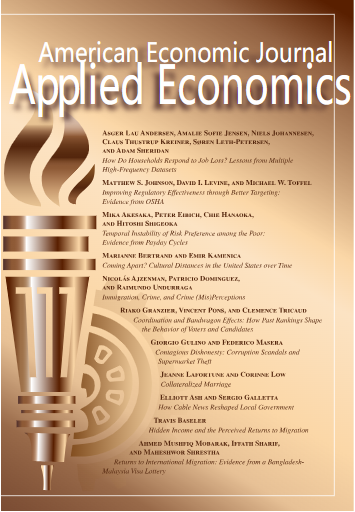基础设施成本
IF 6.2
1区 经济学
Q1 ECONOMICS
引用次数: 4
摘要
尽管基础设施对美国经济至关重要,但有关其成本随时间变化轨迹的证据却很少。我们记录了州际公路系统历史上每新里程的实际支出。我们发现,从20世纪60年代到80年代,每英里的支出增加了三倍多。即使存在可观察到的地理成本决定因素,这种增长也会持续下去。然后,我们提供暗示性的证据来解释原因。投入价格几乎不能解释这一增长。从统计数据来看,收入和房价的变化解释了大约一半的增长。我们发现有启发性的证据表明,政府决策中“公民声音”的兴起增加了每英里的支出。(jel d72, h54, n42, n72, r31, r42)本文章由计算机程序翻译,如有差异,请以英文原文为准。
Infrastructure Costs
Despite infrastructure's importance to the US economy, evidence on its cost trajectory over time is sparse. We document real spending per new mile over the history of the Interstate Highway System. We find that spending per mile increased more than threefold from the 1960s to the 1980s. This increase persists even conditional on pre-existing observable geographic cost determinants. We then provide suggestive evidence on why. Input prices explain little of the increase. Statistically, changes in income and housing prices explain about half of the increase. We find suggestive evidence that the rise of “citizen voice” in government decision-making increased spending per mile. (JEL D72, H54, N42, N72, R31, R42)
求助全文
通过发布文献求助,成功后即可免费获取论文全文。
去求助
来源期刊

American Economic Journal-Applied Economics
ECONOMICS-
CiteScore
9.10
自引率
1.60%
发文量
63
期刊介绍:
American Economic Journal: Applied Economics publishes papers covering a range of topics in applied economics, with a focus on empirical microeconomic issues. In particular, we welcome papers on labor economics, development microeconomics, health, education, demography, empirical corporate finance, empirical studies of trade, and empirical behavioral economics.
 求助内容:
求助内容: 应助结果提醒方式:
应助结果提醒方式:


